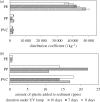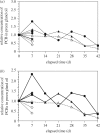Transport and release of chemicals from plastics to the environment and to wildlife
- PMID: 19528054
- PMCID: PMC2873017
- DOI: 10.1098/rstb.2008.0284
Transport and release of chemicals from plastics to the environment and to wildlife
Abstract
Plastics debris in the marine environment, including resin pellets, fragments and microscopic plastic fragments, contain organic contaminants, including polychlorinated biphenyls (PCBs), polycyclic aromatic hydrocarbons, petroleum hydrocarbons, organochlorine pesticides (2,2'-bis(p-chlorophenyl)-1,1,1-trichloroethane, hexachlorinated hexanes), polybrominated diphenylethers, alkylphenols and bisphenol A, at concentrations from sub ng g(-1) to microg g(-1). Some of these compounds are added during plastics manufacture, while others adsorb from the surrounding seawater. Concentrations of hydrophobic contaminants adsorbed on plastics showed distinct spatial variations reflecting global pollution patterns. Model calculations and experimental observations consistently show that polyethylene accumulates more organic contaminants than other plastics such as polypropylene and polyvinyl chloride. Both a mathematical model using equilibrium partitioning and experimental data have demonstrated the transfer of contaminants from plastic to organisms. A feeding experiment indicated that PCBs could transfer from contaminated plastics to streaked shearwater chicks. Plasticizers, other plastics additives and constitutional monomers also present potential threats in terrestrial environments because they can leach from waste disposal sites into groundwater and/or surface waters. Leaching and degradation of plasticizers and polymers are complex phenomena dependent on environmental conditions in the landfill and the chemical properties of each additive. Bisphenol A concentrations in leachates from municipal waste disposal sites in tropical Asia ranged from sub microg l(-1) to mg l(-1) and were correlated with the level of economic development.
Figures












References
-
- Ahrens M. J., Hertz J., Lamoureux E. M., Lopez G. R., McElroy A. E., Brownawell B. J.2001The role of digestive surfactants in determining bioavailability of sediment-bound hydrophobic organic contaminants to 2 deposit-feeding polychaetes. Mar. Ecol. Prog. Ser. 212, 145–157 (doi:10.3354/meps212145) - DOI
-
- Ali L. N., Mantoura R. F., Rowland S. J.1995The dissolution and photodegradation of Kuwaiti crude oil in seawater. Part 2: a laboratory photodegradation apparatus and photodegradation kinetics of a model seawater soluble hydrocarbon (phenanthrene). Mar. Environ. Res. 40, 319–335 (doi:10.1016/0141-1136(94)00149-J) - DOI
-
- Asakura H., Matsuto T., Tanaka N.2004Behavior of endocrine-disrupting chemicals in leachate from MWS landfill sites in Japan. Waste Manag. 24, 613–622 (doi:10.1016/j.wasman.2004.02.004) - DOI - PubMed
-
- Baird R. W., Hooker S. K.2000Ingestion of plastic and unusual prey by a juvenile porpoise. Mar. Pollut. Bull. 40, 719–720 (doi:10.1016/S0025-326X(00)00051-5) - DOI
-
- Barnes D. K. A., Galgani F., Thompson R. C., Barlaz M.2009Accumulation and fragmentation of plastic debris in global environments. Phil. Trans. R. Soc. B 364, 1985–1998 (doi:10.1098/rstb.2008.0205) - DOI - PMC - PubMed
Publication types
MeSH terms
Substances
LinkOut - more resources
Full Text Sources
Other Literature Sources
Miscellaneous

